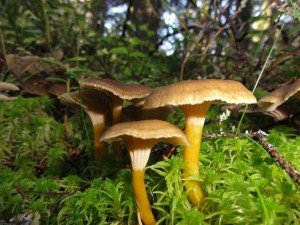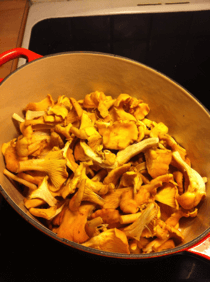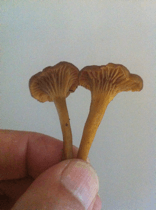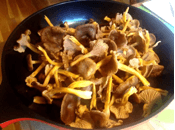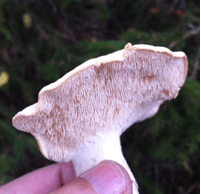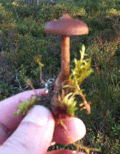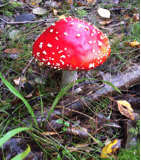Historical background
The Swedish word for fungus is “svamp” (pronounced similar to ‘dump’). The culinary interest of mushrooms and fungi wasn’t sparked in Sweden until 200 years ago. Prior to that, the only known use of fungi was the Vikings’ habit of lacing their mead with fly agaric (more about that later).
The person who raised the interest for eating fungi was the French Marshal Jean-Baptiste Jules Bernadotte, Prince of Ponte Corvo. He arrived to Sweden in September 1810 after having been elected successor to the Swedish throne by the Swedish parliament, and thus adopted by the Swedish king Karl XIII (Charles XIII in English).
When king Karl XIII died a few years later, Prince Bernadotte, now with the new traditionally royal name Karl, and with the name Jean changed to the corresponding Swedish Johan, was crowned as Karl XIV Johan (Charles XIV John in English), thus inaugurating the Bernadotte dynasty, still on the Swedish throne (although nowadays with no power and only symbolic duties).
At this time Sweden was impoverished after several centuries of warfare in continental Europe and Russia, and the people was succumbing of famine. During his journeys through his new kingdom, Karl Johan had observed plentiful occurence of a delicate bolete mushroom he knew from his homeland Corsica, named “stensopp” in Swedish (Boletus Edulis, known as “penny bun” in English), and he suggested that his subjects should learn to eat mushrooms.
“Stensopp” was immediately renamed in the vernacular to “Karl-johans-svamp“, and the interest for using fungi in the kitchen was sparked. Today, on your weekend journey through the Swedish autumn landscape, you will see cars parked everywhere at the forest edge and mushroom pickers criss-crossing between the trees. (This is true at least if you’re traveling in the southern half of Sweden; good fungi that are easy to discern for the beginner are not quite as plentiful in Norrland.) Besides what Swedes pick for their own consumption, hundreds of tons of Karljohan are also picked for export to France and Italy, where they are highly appreciated.
If you are visiting Sweden between July and October, you may take advantage of the customary law known as Allemansrätten, which gives you right to pick mushrooms and berries in any forest or meadow. If you restrict your picking to a few easily recognizable species, you can surprise yourself with a delicious addition to your dinner.
How to pick your own mushroom for dinner (and feel safe)
The problem with mushroom and other fungi is that it’s easy to make dire mistakes, since there are several hundreds of different species. Many species have look-alikes. Some of them are delicious. Others are deadly. If you are not a mycologist, able to discern different species from minuscule differences, you better limit your picking to a few species that are easy to recognize, hard to be mistaken. Luckily, several of the most delicious fungi belong to this category. Here’s a brief introduction for the beginner:
When holding a fungus, trying to decide which species it is, and if it’s edible, start by looking at the spor-bearing surface at the underside of the cap. There are four (common) main types,
- Gills, thin sheet-like plates radiating from the stem, but clearly separated from the stem. These are the most common fungi in Sweden with several hundred of different species. Species can be very difficult to discern. Some are delicious, but several are poisinous, even lethal. Be very careful! Good examples are the champignon / common button, and the portobello; you certainly recognise these from the grocery. (Swedish type name: skivlingar, English: agarics)
- Ridges, short, blunt elevated lines starting on the stem, continuing under the cap; stem and cap are one piece. All fungi of this type that grow in Sweden are edible, most of them delicious. The best example is the yellow or golden chanterelle, considered excellent, difficult to mistake. Great for beginners! (Swedish type name: kantareller, English: chanterelles)
- Pores, many small tubes ending in a spongy surface. A few of these are delicious, such as the aforementioned, highly appreciated, Karljohan. Most of them are however useless, bitter or unpleasant in taste, a few even poisonous or stinking. (Swedish type name: soppar, English: boletes)
- Teeth, many small finger-like projections on the underside, like small thorns (but soft). A good example is the hedgehog mushroom, a good ingredient in many stews, usually mixed with chanterelles or Karljohan. (Swedish type name: taggsvampar, English: tooth fungi)
There are also a few other types, e.g. morels and false morels, some of which are poisonous raw and still carcinogenic after parboiling, but highly recommended just a couple of decades ago. Others are harmless and delicious. If you’re not an expert, stay away from all others than described below!
The good guys…
Karljohan, a.k.a Stensopp
The penny bun (Boletus edulis) belongs to category 3 described above, boletes, with a porous underside on the hat.
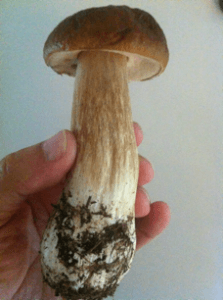
Karljohan appears in small clusters all over Sweden with pine, spruce, or several other trees. It is compact and surprisingly heavy: big specimens can reach a weight close to a kilogram.
The reddish brown cap is convex, almost spherical with a white porous underside on young specimen, gradually flattened with light yellow underside on older specimen. The most typical property is that stem is very thick, bulging or club-shaped, and has a more or less distinct light brown reticular pattern. The flesh is white, sometimes with a pinkish nuance. The flavor is mild and nutty.
Many animals, mammals, insects and snails, love Karljohan, and it’s quite common that someone already has nibbled on your find, but that doesn’t really matter, does it? Just cut away the part that was sampled.
Karljohan is rather common all over Europe and highly appreciated in Italian and French cuisines as well as in the Swedish kitchen. It has a mild, agreeable smell that can remind of almonds, and a similar taste. It’s usually fried in butter, sliced or chopped, with pepper, salt and a few thin slices of garlic or onion, served as a side dish or mixed in soups or sauces, but thin raw slices can also be mixed into a salad with veggies and olive oil.
Relatives: there are a few almost-look-alikes, heavy boletes with a bulbous stem, but as a beginner, you really don’t need to know about them, since they are all less common and, above all, almost as good as Karljohan… except one, in Sweden known as “Gallsopp” (gall bolete). It’s not poisonus, but it’s very bitter and will make your dish unedible. It’s not very likely that you should find one, but in case… remember to avoid similar-looking boletes with a dark brown reticular pattern on the somewhat thinner stem.
Kantarell
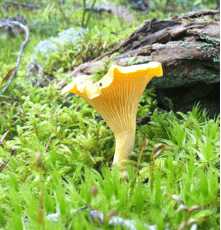
The golden chanterelle (Cantharellus cibarius) is considered to be one of the absolute best fungi in the kitchen, by some chefs considered equal to truffle. In Sweden, this species is what’s meant with “kantarell”; other chanterelles must be qualified with their colour or other characteristics. The golden chanterelle is fairly common from July to September, all over Sweden except the inland of Norrland.
Chanterelles belong to category # 2 above, with hat and stem in one piece, and blunt ridges on the underside of the hat, continuing down on the stem. The color and shape makes it almost impossible to mistake.
Still, mistakes can be made: “falsk kantarell” (false chanterelle) can, at a distance, be taken for a chanterelle, because it’s yellow and has a similar shape with a concave hat, but at a closer look it is easy to see the difference. The false chanterelle has very thin gills (category #1) and a thinner stem that can be broken off; overall, the body is much thinner than a golden chanterelle and has a reddish tone, most visible on the gills. As a contrast, the golden chanterelle is clear yellow and quite stubby in appearance with blunt ridges under the hat: you’ll have no trouble to see the difference once you hold it.
Most of the flavorful compounds in golden chanterelles are fat-soluble, making them good mushrooms to sauté in butter, oil or cream. They also contain smaller amounts of water- and alcohol-soluble flavorings, which lend the mushrooms well to recipes involving wine or other cooking alcohols. Many popular methods of cooking chanterelles include them in sautés, soufflés, cream sauces, and soups.
A very easy and popular side dish with meat is chanterelles sauteed in butter with salt, pepper and a few thin slices of garlic. Or served with a few sauteed onion rings on top of a slice of bread. Or fried with bacon, sage and garlic. Try that on pasta with crème fraiche and cottage cheese. Yummy!
You may be surprised by the fact that chanterelles are very rich in vitamins and wholesome minerals. In particular, chanterelles are one of the richest sources of vitamin D known, with as much as 2500 IU of ergocalciferol (vitamin D2) per 100 grams fresh weight. Chanterelles are also relatively high in vitamin C (0.4 mg/g fresh weight), and very high in potassium (about 0.5%, dry weight).
Scientific research suggest that the golden chanterelle may have potent insecticidal properties that are harmless against humans and yet protects the mushroom body against insects and other potentially harmful organisms. This explains why you most often find chanterelles intact, without traces of being eaten by larvae or snails. They are sometimes eaten by deer, but of course, that doesn’t leave any trail, since they’ll eat the entire mushroom. 🙂
Trattkantarell
The golden chanterelle has a few relatives, which also are considered delicious.
A common relative to the golden chanterelle is trattkantarell (“tratt-“ means funnlel) in English known as funnel chantarelle, yellowfoot or winter mushroom (Craterellus tubaeformis, or Cantharellus tubaeformis in older taxonomy).
Trattkantarell can be found in large numbers in spruce forests, all over Sweden. The English name “Winter mushroom” is quite descriptive when it comes to picking season: the first ones appear in September, and can be picked, or rather harvested, until they are covered with snow. They’ll be frozen and snap when you pick them, but still good… delicious!
Trattkantarell is the most humble mushroom in the forest. Size and colour may vary, but since they usually are rather small and brownish-grey, it’s easy to walk across thousands without seeing them. But once you kneel after seeing one, you will discover that there are in fact a thousand where you just stepped.
You can easily recognise trattkantarell by the “chanterelle shape” with hat and stem in one piece that can’t be separated and ridges (not gills) on the underside. The most typical characteristic is however that it usually is hollow from top to bottom, like a funnel.
It contains quite a lot of water, why cooking always begins by parboiling until most of the water has disappeared. Like it’s relative kantarell (golden chanterelle), trattkantarell is very flavourful. The flavours develop best when sauteed in butter and then simmered in double cream, perhaps with a dash of portwine. It’s often served with moose or deer steaks, and works just as fine with beef.
One of my favorite ways to use it is this: first sauteed in butter with a couple of onion rings, them simmered in double cream with salt, black pepper, rosemary, and two or three ground berries of juniper. Add a little stock concentrate if you want a “meatier” taste. Serve over a heap of tagliatelle (spaghetti straps) with a handful of dried green pepper corns on top.
If you have picked more than you can eat at one time, you can save the surplus in your freezer after parboiling them with a pinch of salt until all the water has evaporated; just don’t use butter in this stage (butter decomposes in the freezer). When cool, you can apportion them in plastic bags for the freezer. You can also save them in dried format: set the oven to 70C (=160F), put the mushrooms as they are on a grid, leave the hatch ajar. The first method works fine also with golden chanterelles, but not the second; dried golden chanterelles lose flavor and become slightly bitter.
The funnel chantarelle has a couple of siblings, equally good:
- Rödgul trumpetsvamp (“orange trumpet mushroom”) – looks like trattkantarell, slightly bigger and with an orange stem. Can end up in your basket by mistake but you won’t discover the mistake, its delicious.
- Svart trumpetsvamp (“black trumpet mushroom”) – looks almost like trattkantarell but is all black and thinner in shape. Rare, grows only in southern Sweden, preferably under oak and hazel. Considered absolutely superb!
Champinjon
Everybody who has been into a grocery store knows what a champignon or common button (Agaricus campestris/bisporus) looks like. Champignons are of type #1 above, i.e. they have gills, that initially are covered by a thin film.
You can find a few varieties of this species on fields that have been grazed by bovines. They may not be snow white like the ones in the grocery store, they may in fact be brown as a portobello (which actually is a champignon too), but since they’re grown in the wild, they will have more flavour than the ones in the grocery.
Just make sure that the gills are brown or black! Pink gills can be accepted on very young specimen, just do not pick mushrooms with purely white gills! (Mushrooms that look like champignons but have white gills are probably death caps or destroying angels – extremely poisonous, lethal!)
Blek taggsvamp
Another delicious mushroom that can’t be mistaken for some other species is the hedgehog (Hydnum repandum), in Sweden called “blek taggsvamp” (~pale thorny mushroom). It belongs to category #4 above, and has teeth-like thorns on the underside. However, the “thorns” are soft and will fall off when you touch them. A picture is said to tell more than a thosuand words, but to accurately describe blek taggsvamp you won’t need more than a dozen words. No picture needed, but here’s one anyway.
As the Swedish name suggests, it’s pale, almost white, sometimes with a pinkish tone, and “thorns” on the underside. It’s excellent in the kitchen, very mild in flavour and therefore often mixed with other mushrooms such as Karljohan or chanterelles.
There are also a few other related species of taggsvamp. They’re all edible, although not worth picking – don’t bother with them.
The Killer Mushrooms in Sweden
Spindelskivling
You’ll probably be looking for chanterelles or funnel chanterelles, since they are relatively common and easy to recognize. All chanterelles are in fact edible, and delicious! But tragic accidents sometimes happen, when pickers don’t look out for the true “chantarelle characteristics”, i.e. the trumpet-like shape, hat and stem in one piece, and ridges, not gills, on the underside.
Knowing the typical looks of chanterelles, it seems hard to believe that people sometimes have been killed because they’ve eaten “toppig spindelskivling” (~ topped spider agaric), or deadly webcap in English. Notice that the cap is convex instead of concave, and it usually has a pointed tip in the middle. And it’s an agaric, with gills. And you can easily separate the cap from the stem.
If picked by mistake, you should easily find and throw it out when you’re cleaning your harvest at home, before cooking. As long as you look for the funnel shape, you’re safe.
Flugsvampar
It might also have been proper to describe, and warn you for, another illreputed family of mushrooms, namely the family Amanita, called “flugsvamp” (fly mushroom) in Swedish. But since I’ve already told you, being a beginner, never pick a mushroom with white gills, it might be lethal, that won’t be necessary. Later, when you’ve become an expert, you’ll learn that there are in fact a whole lot of delicious mushrooms with white gills, but you’ll need expertise to recognize them.
Still, these are their names:
- Röd flugsvamp, (“red fly mushroom”), Amanita muscaria, in English known as fly agaric
- Vit flugsvamp, (“white fly mushroom”), Amanita virosa, in English known as destroying angel
- Lömsk flugsvamp, (“sneaky fly mushroom”), Amanita phalloides, in English known as death cap.
You’re not very likely to pick the bright red fly agaric by mistake, but the destroying angel and the death cap might look like a champignon. Until you turn it upside down to discover that the gills are purely white.
But, yes, the Vikings picked röd flugsvamp 1,000 years ago, to lace their mead. The effect is said to be like a combination of alcohol and LSD, i.e. you get drunk and hallucinate. One of the side effects is that you may die. The other side effect is that if the dose didn’t kill you, you’ll wake up next morning in a very bad temper with the worst hangover you ever had, still hallucinating. In that state of mind, Vikings might sometimes go berserk, smashing, destroying and killing everything in their way, still wearing their night clothes. That’s actually the origin of the word “berserk”. The word “berserk”, spelled bärsärk in Swedish, is made up from two words: bär means wear, and särk is a chemise or nightgown. But don’t be afraid for Swedes in pajamas, we’ve ceased drinking laced mead. And by the way… don’t try this at home!
Help support SwedishFreak!
Purchase some mushroom picking supplies below and help support our website.
No products found.
